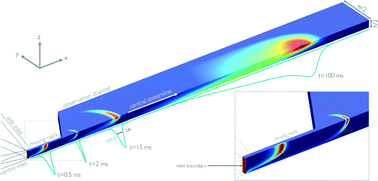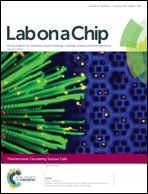Taylor dispersion and the position-to-time conversion in microfluidic mixing devices
Abstract
Microfluidic mixing devices are increasingly popular tools for probing the non-equilibrium dynamics of biomolecular systems. Commonly, hydrodynamic focusing is used to reduce the length scales that limit the time of diffusive mixing in the laminar flow regime, such that even sub-millisecond dead times for triggering a reaction have been achieved. Detection of a suitable signal at different points along the channel downstream of the mixing region, corresponding to different times after mixing, then allows the kinetics of the reaction to be obtained. However, the requisite accurate conversion of the positions in the channel to times after mixing is complicated by Taylor dispersion, the combined effect of diffusion and shear flow on the dispersion of the molecules in the microfluidic device. As a result, an accurate position-to-time conversion has only been possible in the limiting regimes, i.e. for very early times, where sample diffusion can be neglected, and for very long times, where the molecules have uniformly sampled the entire channel cross-section. Here, we use detailed three-dimensional, time-dependent finite-element calculations to obtain an accurate position-to-time conversion that bridges these two limits and allows us to quantify the effects of Taylor dispersion on the time resolution of a representative mixing device optimized for single-molecule fluorescence detection. The accuracy of the calculations is confirmed by direct comparison of the calculated velocity field with dual-focus fluorescence correlation spectroscopy measurements.


 Please wait while we load your content...
Please wait while we load your content...